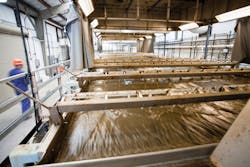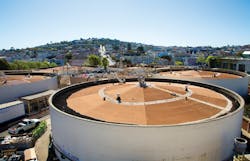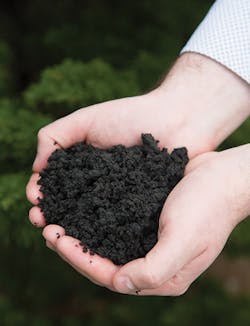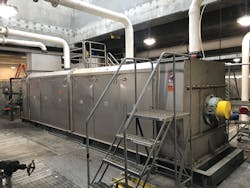SFPUC’s biosolids program recognized for excellence three years in a row
Every day, the San Francisco Public Utilities Commission (SFPUC) treats millions of gallons of wastewater at its two treatment facilities. In 2017, 63,000 tons of biosolids were produced at SFPUC sites, used to create biofertilizer, applied to pasture lands as a synthetic fertilizer replacement and deployed as a soil alternative when covering landfills. Recently, SFPUC received platinum-level certification for its Biosolids Management System (BMS) from the National Biosolids Partnership (NBP). It was the third year in a row the Commission received the award.
“We take our mission of being responsible stewards of the environment seriously,” SFPUC General Manager Harlan L. Kelly, Jr., said in a press release about the award. “Our biosolids program is an excellent example of our agency’s commitment to shifting from wastewater treatment toward resource recovery.”
SFPUC’s Biosolids Management System received platinum-level certification from the National Biosolids Partnership.
The NBP was founded in 1992 as an alliance between the Water Environment Federation, the National Association of Clean Water Agencies, and the Environmental Protection Agency. Its mission was — and still is — to support and advance biosolids management programs through education, training and technical assistance. Some 34 organizations currently operate NBP-certified programs at varying levels of recognition: bronze, silver, gold, and platinum.
The San Francisco Treat(ment)
SFPUC’s two wastewater treatment plants, Southeast and Oceanside, separate biosolids from the wastewater through settling and a gravity belt thickener. Afterward, they are sent to digesters where microorganisms remove harmful bacteria and other pathogens, break down pollutants, and produce biogas during the process.
“We separate out the solids and biologically convert them into a high-quality soil amendment,” SFPUC Press Secretary Will Reisman said. “These biosolids are then used by farmers and ranchers in the Bay Area to promote plant growth and build healthy soil. Because biosolids are carbon-based, they improve soils in ways that conventional petroleum-based or mined fertilizers cannot. Using biosolids is a way to recycle plant nutrients and carbon back to soils where they came from and belong.”
Microorganisms inside digesters remove harmful bacteria and other pathogens, break down pollutants, and produce biogas.
The anaerobic digesters at SFPUC’s Oceanside Treatment Plant are operated in a Temperature Phased Anaerobic Digestion (TPAD) system. Solids first enter one of three thermophilic digesters and are kept at a near constant 131°F for a solids retention time of 25 days. After thermophilic digestion, material is then sent to a single mesophilic anaerobic digester, which maintains 100°F for a solids retention time of eight days. After digestion, the solids are sent to a screw press that compacts them to drain even more moisture from the material.
At the Southeast Treatment Plant, digesters are kept at a near constant 9°F for 15 days. After digestion, the solids are sent to centrifuges, which spin the solids at a high speed to separate out the moisture.
The Biosolids Management System (BMS) Manual is an operations manual for how SFPUC runs the biosolids program. It “serves as a model for continuous improvement in the areas of environmental performance, regulatory compliance, quality management practices, and relations with key external stakeholders,” Reisman said.
In 2017, 63,000 tons of biosolids were produced at SFPUC sites.
“The BMS Manual is a living document that is constantly updated as new information is obtained, changes to the existing systems occur, and experience is gained in implementing the BMS,” he added.
In 2016, the SFPUC passed an external-party audit and became an NBP-certified agency with platinum level recognition, indicating the SFPUC’s commitment to the BMS, commitment to conducting internal audits, and commitment to completing, at a minimum, one third-party audit every five years.
San Francisco’s biosolids program first received platinum certification in June 2016 following a rigorous review process by a third-party independent audit. To maintain certification, the program staff conducted annual internal audits and met the high standards required at each step of the treatment process by the NBP. This is a voluntary program, prescribed by the NBP’s Code of Good Practice, which helps build public confidence and trust between communities and biosolids producers. Fewer than 25 programs nationwide have achieved this level of recognition.
“As this is a voluntary program, the SFPUC aims to show not only [within] our San Francisco community but also regionally that biosolids are a valuable resource,” said Reisman. The use of biosolids helps improve soil health, leads to healthier plant growth and sequesters carbon from the atmosphere, helping to combat climate change, he added. “Our BMS demonstrates that our biosolids practices are informed by science and that our biosolids meet rigorous safety standards.”
After digestion, the solids are sent to a screw press to complete the dewatering process.
Given that less than 25 programs have reached this level of certification nationwide, San Franciscans can take pride in knowing that their local utility provider is committed to excellence. As further evidence of its commitment to the BMS, the SFPUC has pledged that 100 percent of its biosolids will be used for beneficial endeavors. WW
Author’s Note: The San Francisco Public Utilities Commission (SFPUC) is a department of the City and County of San Francisco. It delivers drinking water to 2.7 million people in the San Francisco Bay Area, collects and treats wastewater for the City and County of San Francisco, and generates clean power for municipal buildings, residents, and businesses. Learn more at www.sfwater.org.
About the Author

Alanna Maya
Chief Editor
Alanna Maya is a San Diego State University graduate with more than 15 years of experience writing and editing for national publications. She was Chief Editor for WaterWorld magazine, overseeing editorial, web and video content for the flagship publication of Endeavor's Water Group. In addition, she was responsible for Stormwater magazine and the StormCon conference.




